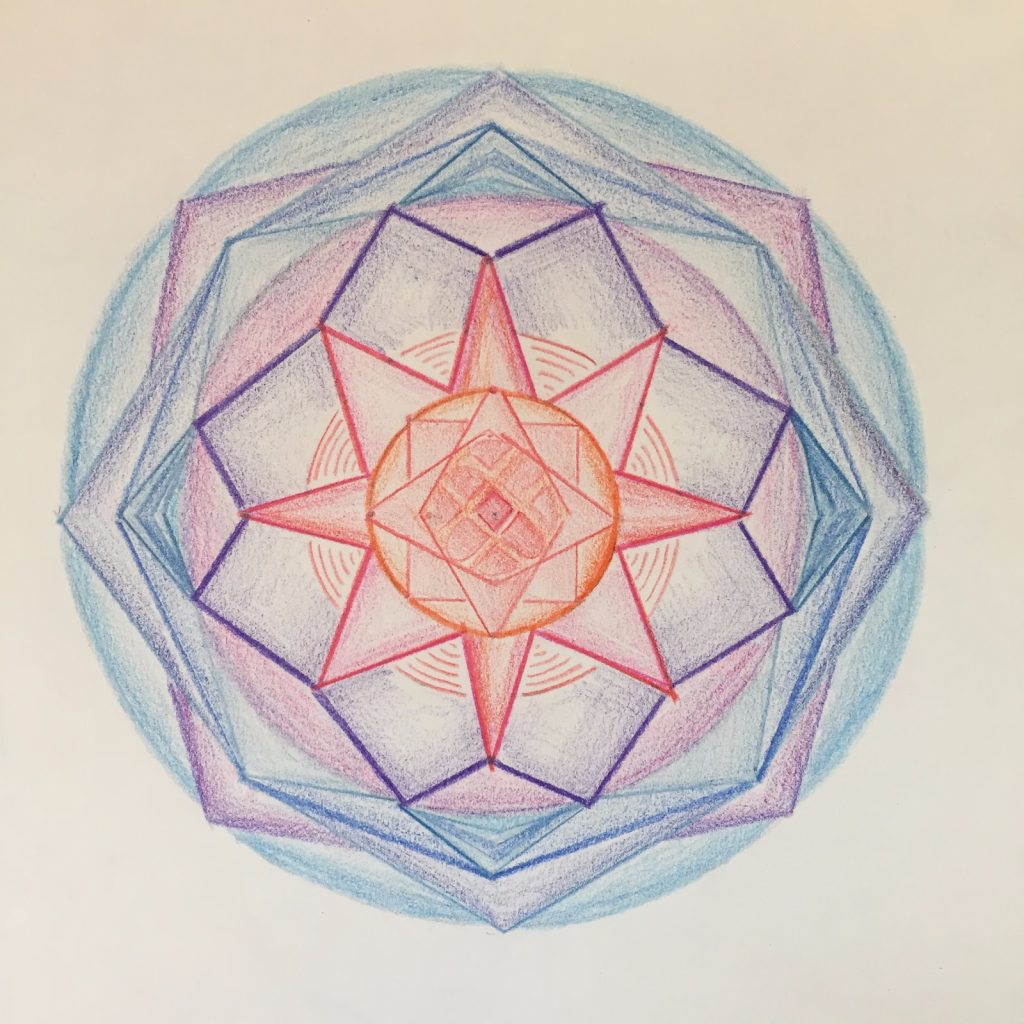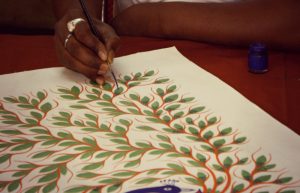The Challenge: Our fast-paced lives leave us feeling stressed and anxious, even when the workday is over.
The Science: Coloring mandalas is a simple technique to ground us at the moment, de-clutter our minds, and soothe our stress.
The Solution: Make time in your daily schedule to ditch your cell phone and color.
Life is stressful.
Many of us are juggling multiple demands – holding down a job (or three), caring for family and friends, managing our crammed calendars. We (or our loved ones) will inevitably face illness or chronic pain. Some of us may be coping with financial insecurity, relationship instability, job stress, or grief. Our hearts may ache from the weight of the world around us. These life stressors, big and small, can make us feel sad, worried, agitated, or self-conscious. Our fast-paced lives leave us with over-extended schedules, fluttering hearts, and cluttered minds.
Although the last thing we may want is another activity added to our schedules, one particular activity might be worth our precious time: coloring.
Specifically, coloring mandalas – visual structures comprising interlocking circles and other geometric shapes – carries benefits for well-being.
What are mandalas?
Mandalas have their roots in Hinduism and Buddhism. Mandala – Sanskrit for “circle” – is both a symbol and a ritual. As a symbol, mandalas represent harmony, wholeness, and the infinite nature of the universe. As a ritual, the mandala helps facilitate meditation. The creation of mandalas requires intense focus, stillness, and attention to the present moment –key components of mindfulness meditation. Mandalas always begin from the epicenter and grow outwardly. Mandalas commonly include many concentric circles and are often symmetrical. In the context of Buddhism, different layers of the mandala represent different aspects of the universe and cycle of life. Thus, mandalas hold great spiritual significance and represent concepts such as compassion.
Mandalas, mindfulness, and well-being
Because mandalas require attentive focus and calmness to create and color, mandalas can help cultivate mindfulness, self-awareness, and stress relief.
In the early 1900s, psychoanalyst Carl Jung incorporated mandalas into therapeutic settings. He observed that creating mandalas helped patients resolve past trauma and current conflicts.
Since then, researchers have studied the mandala’s healing powers in the lab.
Nancy Curry and Tim Kasser conducted a randomized experiment to examine the healing potential of mandalas. Adults came into the lab completed a baseline anxiety questionnaire, and then underwent an anxiety induction: they were asked to think and write about a time when they felt very fearful. Participants then completed a second anxiety questionnaire. Finally, participants were randomly assigned to one of three conditions and asked to color either a (1) blank page, (2) a mandala, or (3) an irregular geometric design. After coloring for 20 minutes, participants completed a third and final anxiety questionnaire.
Adults who colored a blank page demonstrated no change in anxiety after the coloring activity. Remarkably, participants who colored a mandala not only demonstrated reductions in anxiety but also reported lower anxiety levels than when they entered the lab.
However, the authors of this study observed no difference in anxiety reduction between the mandala condition and the geometric design condition. The authors speculated one potential reason – participants were given pre-drawn coloring pages rather than being permitted to create their own designs.
To address this limitation, Patti Henderson, David Rosen, and Nathan Mascaro invited adults with posttraumatic stress disorder (PTSD) to create mandalas of their own. Participants completed a drawing activity for 20 minutes a day over a 3-day period. Adults were randomly assigned to one of two conditions: create a mandala (i.e., draw a large circle and fill it with symbols, patterns, designs, and colors – but no words), or draw a static object (e.g., a cup). Participants completed mental health questionnaires before and after this 3-day period, as well as one month later. After the 3-day intervention, participants who created mandalas (versus those who drew static objects) demonstrated significant improvements in mental health, including depression, anxiety, and post-traumatic stress. Remarkably, these improvements persisted upon the 1-month follow-up.
When we create or color mandalas, our minds become absorbed in the current moment. According to Nancy Curry and Tim Kasser, “When individuals color complex geometric forms, they are provided an opportunity to suspend their ‘inner dialogue’ and to deeply engage in an activity that removes them from the flow of negative thoughts and emotions that can sometimes dominate their lives.”
Mindfulness involves bringing our attention to the current moment. Mindfulness also involves non-judgmental awareness of our thoughts, emotions, and surroundings. Mandalas help to cultivate this mindfulness. By focusing on the shapes, patterns, and colors, we orient our senses to the present moment. And this immersion in the present moment can help shield us from the crushing weight of daily hassles and major life interruptions.
What to do
Importantly, remember that the purpose of creating and coloring is the process and not necessarily the outcome. Don’t worry about producing a grand piece of art; don’t fret about creating a perfectly symmetrical mandala. Simply enjoy your time away from your email account, overcrowded calendar, and daily hassles.
From time to time, our mental chatter may distract us – but by re-orienting our attention to the patterns and colors on the page before us, we can bring our attention back to the drawing before us. Ultimately, maintaining our attention on the mandala is a method to maintain our attention to the present moment. And it is this mindful awareness that will fill us with feelings of tranquility, harmony, and ease.
Nancy Curry and Tim Kasser recommend that adults color before events that give them anxiety, such as taking a test or flying on an airplane. Coloring can also be a great activity to do during a lunch break or as a replacement for mindless web browsing after work.
Blue Star Books provides some excellent guidelines in the Adult Coloring Book: Stress Relieving Patterns:
“Break out your crayons or colored pencils. Turn off your phone, tablet, computer, whatever. …. Start coloring. If you notice at any point that you are forgetting your worries, daydreaming freely, or feeling more creative, curious, excitable, delighted, relaxed, or any combination thereof, take a deep breath and enjoy it. Remind yourself that coloring, like dancing or falling in love, does not have a point. It is the point. When you don’t feel like it anymore, stop.”
Pictured below: A mandala that I created as a break from writing my dissertation

Resources:
- Tibetan Sandpainting: As part of their training, Buddhist monks are taught to create mandalas out of sand. Sand of different colors is used to “paint” a mandala upon a surface. The creation of mandalas can range from several hours to many days. When the mandala is complete, the sand is gathered into a pile and carried into a body of water. This offering – and “destruction” of the mandala – represents the impermanence of reality. Here is a time-lapse video portraying the making of a mandala by Tibetan monks.
- A guided video titled How to Grow a Mandala
- An assortment of mandala coloring books (Amazon.com)
- An assortment of mandala workbooks (Amazon.com)
- Free printable mandala coloring pages (Google Image Search)
- “Polar paper” to help create your own mandalas from scratch
For more reading:
A related piece on how creating art can help cultivate mindfulness
Curry, N. A., & Kasser, T. (2005). Can coloring mandalas reduce anxiety? Art Therapy, 22(2), 81–85. doi:10.1080/07421656.2005.10129441
Henderson, P., Rosen, D., & Mascaro, N. (2007). Empirical study on the healing nature of mandalas. Psychology of Aesthetics, Creativity, and the Arts, 1, 148–154. doi:10.1037/1931-3896.1.3.148
Jung, C. G. (1959). Mandala symbolism. Princeton, NJ: Princeton University Press.
Schrade, C., Tronsky, L., & Kaiser, D. H. (2011). Physiological effects of mandala making in adults with intellectual disability. The Arts in Psychotherapy, 38, 109–113. doi:10.1016/j.aip.2011.01.002
van der Vennet, R., & Serice, S. (2012). Can coloring mandalas reduce anxiety? A replication study. Art Therapy, 29(2), 87–92. doi:10.1080/07421656.2012.680047



